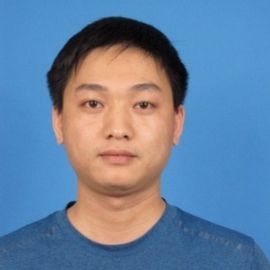Agenda
Webinar Schedule
Day 1 full schedule
November 15, 2021 @ 10:00 - 01:40

Shyamapada Mandal
ProfessorUniversity of Gour Banga
India
ABSTRACT
Among various enzymes that involve in the cancer development, cyclin dependent kinase-2 (CDK-2) is an important one, and hence blocking the activity of CDK-2 is an important strategy in drug discovery to identify new potential therapeutics using bioinformatic tools. In this study five phytochemicals (ajmalicine, cajaisoflavone, cocculine, diosgenin and piperine) along with one CDK-2 inhibitor (vanoxerine) were retrieved from PubChem in 3D forms, (.sdf). These agents were used as ligands in molecular docking against a cancer protein CDK-2 (X-ray diffraction structure downloaded from RCSB protein data bank with ID 1DI8). The molecular docking revealed the binding energy of -10.6 kcal/mol (ajmalicine), -8.8 kcal/mol (cajaisoflavone), -6.5 kcal/mol (cocculine), -9.2 kcal/mol (diosgenin), -8.7 kcal/mol (piperine), -9.2 kcal/mol (vanoxerine) against CDK-2, hydrogen bonds and hydrophobic interactions. Further, molecular dynamic simulation and pharmacokinetics (Lipinski’s RO5, oral bioavailability and ADMET properties) studies authenticated the usefulness of the currently studied phytochemicals, compared to vanoxerine, in the inhibition of CDK-2 target protein thereby preventing cancer.
Personalized and Precision Medicine (PPM) as a Unique Healthcare Model to Be Set Up via Biodesign, Bio- and Chemical Engineering, Translational Applications, and Upgraded Business Modeling to Secure t

Sergey Suchkov
ProfessorA.I. Evdokimov Moscow State University, Russia
ABSTRACT
Traditionally a disease has been defined by its clinical presentation and observable characteristics, not by the underlying molecular mechanisms, pathways and systems biology-related processes specific to a particular patient (ignoring persons-at-risk). A new systems approach to subclinical and/or diseased states and wellness resulted in a new trend in the healthcare services, namely, personalized and precision medicine (PPM).
To achieve the implementation of PPM concept, it is necessary to create a fundamentally new strategy based upon the biomarkers and targets to have a unique impact for the implementation of PPM model into the daily clinical practice and pharma. In this sense, despite breakthroughs in research that have led to an increased understanding of PPM-based human disease, the translation of discoveries into therapies for patients has not kept pace with medical need. It would be extremely useful to integrate data harvesting from different databanks for applications such as prediction and personalization of further treatment to thus provide more tailored measures for the patients and persons-at-risk resulting in improved outcomes and more cost effective use of the latest health care resources including diagnostic (companion ones), preventive and therapeutic (targeted molecular and cellular) etc.
Translational researchers, bio-designers and manufacturers are beginning to realize the promise of PPM, translating to direct benefit to patients or persons-at-risk. For instance, companion diagnostics tools and targeted therapies and biomarkers represent important stakes for the pharma, in terms of market access, of return on investment and of image among the prescribers. At the same time, they probably represent only the generation of products resulting translational research and applications. So, developing medicines and predictive diagnostic tools requires changes to traditional clinical trial designs, as well as the use of innovative (adaptive) testing procedures that result in new types of data. Making the best use of those innovations and being ready to demonstrate results for regulatory bodies requires specialized knowledge that many clinical development teams don’t have. The areas where companies are most likely to encounter challenges, are data analysis and workforce expertise, biomarker and diagnostic test development, and cultural awareness. Navigating those complexities and ever-evolving technologies will pass regulatory muster and provide sufficient data for a successful launch of PPM, is a huge task. So, partnering and forming strategic alliances between researchers, bio-designers, clinicians, business, regulatory bodies and government can help ensure an optimal development program that leverages the Academia and industry experience and FDA’s new and evolving toolkit to speed our way to getting new tools into the innovative markets.
Healthcare is undergoing a transformation, and it is imperative to leverage new technologies to support the advent of PPM. This is the reason for developing global scientific, clinical, social, and educational projects in the area of PPM and TraMed to elicit the content of the new trend. The latter would provide a unique platform for dialogue and collaboration among thought leaders and stakeholders in government, academia, industry, foundations, and disease and patient advocacy with an interest in improving the system of healthcare delivery on one hand and drug discovery, development, and translation, on the other one, whilst educating the policy community about issues where biomedical science and policy intersect.
ANTI-FIBROTIC AND REGENERATIVE EFFECTS OF A NOVEL SENOLYTIC PHYTOMARINE AND A COMBINED ANTI-INFLAMMATORY FORMULA IN EXPERIMENTAL CHRONIC PANCREATITIS: AVENUES TO CLINICS?

F. Marotta
ProfessorUSA
ABSTRACT
Back in 1988 (Hirosaki Univ., Japan) we were the first proving the macrophage/fibroblast-pancreas stellate cells (PSC) transformation in a chronic pancreatitis (CP) model. The progression of fibrosis remains a clinical challenge in CP, whatever the etiology. We have published on a unique phytomarine (RL) formula with remarkable senolytic/vitagenic-upregulator properties with stem cell-enhancement (CAS, 2021). In a experimental BPCO model, this RL exerted anti-inflammatory effect and promoted lung epithelial regeneration. Based on a multicenter pilot study, we have also promising data from a unique liver protector polyphytocompound (FOLHK). Thus, our aim was to test the above compounds in a CP model induced in rats by L-arginine injection and a exposure to 6Gy. Food was added with 100 mg/kg of A) RL; B) RL + FOLHK; C) control. Sacrifices at 0, 2, 4 ,8 wks measured levels of TNF-α, IL-1β, IL-8, hyaluronic acid (HA) and laminin (LN). The gene expressions were: fibronectin 1 (FN1), typeI collagen (COL I-α1), α-SMA, TGF-β, sonic hedgehog (SHH) and microRNA181b. Either RL and FOLHK significantly improved serum level of IL-1β and IL-8 (p<0.05), B treatment yielded better results than RL alone (p<0.05) and the same with HA and LN (p<0.01). Tx A and, to a greater extent, B Tx significantly mitigated PSC activation, ECM deposition, fibrogenesis, mast cell (MC)-accumulation and acinar atrophy in CP model (p<0.05). At baseline the histological score correlated with gene expressions for fibrosis (p<0.01). Combined Tx more significatnly downregulated FN1, MCP-1, COL I-α1, α-SMA, TGF-β and SHH (p<0.01). A robust tissue upregulation of Sirt-1 and miR-181b was yielded by RL (p<0.01) and FOLHK was of no futher benefit. Pancreatic adenoK and CP share a desmoplastic phenomenon involving PSCs. Our study showed that by combining a senolytic/vitagenes-upregulating/stem cell-enhancing compound with an antiinflammatory phytomixture we could partly prevent the fibrogenesis and progression and potential reversal.
An ex vivo strategy based on standardized drug containing plasma and the absorbed ingredients combination to discovery of active substances and mechanism of herbal formula, a case study of Xian-Ling-G

Zuo-cheng Qiu
assistant researcherChina
ABSTRACT
The overall therapeutic effect of herbal formula was achieved by the interactions with multi-components and multi-targets. However, current strategy has struggled to identify active substance groups and encountered challenges in elucidating its underlying mechanism. In this study, an ex vivo strategy was proposed. Firstly, the clinical efficacy of herbal formula was simulated using a well-recognized animal disease model, and the overall perturbation mechanism of herbal formula on the model was analyzed by omics methods. Secondly, the main components absorbed in plasma/serum were comprehensively characterized and the exposure of multiple components in vivo was analyzed. Thirdly, the preparation of drug-containing plasma/serum was standardized, and its pharmacological effects were evaluated, followed by the discovery of substance groups in drug-containing plasma/serum through the combination and knockout of the absorbed components. Finally, the systemic effects of herbal formula on disease treatment are deciphered by fully integrating information from target prediction and network pharmacological analysis of bioactive absorbed components and linking them to genes or pathways enriched by omics analysis. In order to interpret this strategy, the famous herbal formula: Xian-Ling-Gu-Bao (XLGB) capsule was taken as an example. As a result, a total of 18 genes, including HDC, CXCL1/2 were newly found to be the major anti-osteoporosis genes regulated by XLGB. Interestingly, we found that a combination of the three absorbed components, Magnoflorine-Sweroside-Psoralen (M-S-P), synergistically stimulated the bone formation of osteoblasts. Besides, target validation confirmed the novel binding affinity of corylin, icaritin for estrogen receptor α/β; the inhibitory activity of isobavachin, isobavachalcone on GSK 3β; and the inhibitory activity of isobavachalcone on cathepsin K. Our current study provides a new ex vivo strategy for discovering synergistic components in herbal formula and understanding their underlying mechanisms. The combination of M-S-P from XLGB was promising candidate for the development of anti-osteoporosis drug in the future.

Jyotirmoi Aich
Assistant ProfessorSchool of Biotechnology and Bioinformatics, DY Patil Deemed to Be University
D Y Patil Deemed To Be University, India
ABSTRACT
Cancer is a complex disease affecting millions of people around the world. Breast cancer is one of the most frequently diagnosed cancer and the leading cause of cancer related deaths among women. Despite advances in surgical and radiation therapy, chemotherapy continues to be an important therapeutic option for the treatment of cancer. The current treatment is expensive and has several side effects. Also, over a period of time cancer cells develop resistance to the chemotherapeutic drugs due to which there is a demand for new drugs. Drug repurposing is a novel approach that focuses on finding new applications for the old clinically approved drugs. The process of drug repurposing has been facilitated by current advances in the field of proteomics, genomics and computational biology. Drug Repurposing approach not only provides cheaper, effective and safe drugs with less side effects but also fastens the process of drug development. The aim of the present study is to identify a potential Antipsychotic drug that can be repurposed for the treatment of breast cancer based on the in silico and in vitro studies. A list of Antipsychotic drugs having anticancer potential was obtained through literature survey and by using the ReDO database. Molecular docking studies were performed for all these drugs with the receptors upregulated in breast cancer using AutoDock Vina. Brexpiprazole, an atypical antipsychotic drug, showed high binding affinity towards all the receptors. In vitro cytotoxicity study of Brexpiprazole was performed on the MCF-7 Breast cancer cell line. The IC50 value for Brexpiprazole was found to be 10.14 µM. Significant morphological alterations were observed when MCF-7 cells were treated with different concentrations of Brexpiprazole. Therefore, based on the in silico and in vitro studies it can be concluded that Brexpiprazole is a promising drug candidate for repurposing in breast cancer.

Satyajit Patra
Associate ProfessorAmerican International Medical University
St Lucia
ABSTRACT
Artificial intelligence has reformed the diagnostic and therapeutic precision and competence in various fields of medicine. Artificial intelligence appears to play a bright role in medical diagnosis. John McCarthy first described the term AI in 1956 as the science and engineering of making intelligent machines. Computer systems using artificial intelligence help in the assessment of medical images and enormous data. This research aims to identify how artificial intelligence-based technology is reforming the art of medicine. Artificial intelligence empowers providers in improving efficiency and overall healthcare. Newer machine learning techniques lead the automatic diagnostic systems. Areas of medicine such as medical imaging, automated clinical decision-making support have made significant advances with respect to artificial intelligence technology. With improved diagnosis and prognosis, artificial intelligence possesses the capability to revolutionize various fields of medicine. Artificial intelligence has its own limitations and cannot replace a bedside clinician. In the evolving modern medical digital world, physicians need to support artificial intelligence rather than fear it replacing trained physicians for improved healthcare.
The unsuspected intrinsic property of human body to dissociate the water molecule, like the plants. Implications in Pharmacology

Arturo Solis Herrera
Director and FounderMexico
ABSTRACT
Current pharmacology is based on a dogma dearly rooted in biology that the main source of energy in the human body is glucose. This erroneous belief dates to the times of Lavoisier and Priestley, where it was proclaimed that our body combines the oxygen, we breathe with the glucose we obtain through food to obtain the energy necessary to drive all the chemical reactions that make us up.



